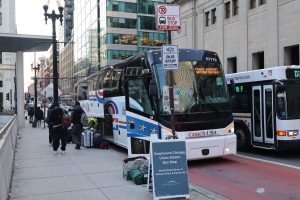Three state bills would bring millions to Illinois passenger rail, intercity buses
By Igor Studenkov for Chronicle Media — March 13, 2025
Van Galder intercity bus route arrives at Union Station after making stops in Rockford and South Beloit. (Photo by Igor Studenkov/for Chronicle Media)
High Speed Rail Alliance, a Chicago-based advocacy group, is throwing its support behind three state bills that, if passed, would put significant resources into expanding passenger rail and intercity buses throughout Illinois.
The first bill would appropriate $575 million to maintain and expand intercity passenger rail services throughout the state, with about one-eighth of it going toward high-speed rail. The second bill would appropriate a more modest $90 million towards several long-discussed rail projects, including currently under development Chicago to Rockford service. The third bill would require the Illinois Department of Transportation to create a more extensive, state-managed intercity bus network.
All three bills were introduced in both houses of the Illinois General Assembly in the beginning of February. They are still early in the legislative process, and they don’t have any co-sponsors as of this issue’s deadline.
HSRA has long pushed for the state to invest more in passenger rail and improve transit options. It touted the three bills as meaningful steps toward those goals. They also argued that the bills would help freight railroads, since rail improvements would make all trains faster and safer, and “bring new life to communities” throughout Illinois.
“The passage and implementation of these bills would establish Illinois as the nation’s leader in passenger rail innovation,” it stated. “By ensuring strong funding, thorough planning, and integrated bus-rail operations, these bills promise a future where residents can hop on a fast train or a connecting bus to reach every corner of the state.”
IDOT currently subsidizes three Amtrak routes that either wholly or mostly within Illinois, and it partially subsidizes Chicago-Milwaukee Hiawatha service and Chicago-St. Paul, Minnesota Borealis service. The intercity buses are mostly left in the hands of the private companies, with IDOT subsidizing two routes.
State Passenger Rail Program bill
This bill was introduced in Illinois House by State Rep. Matt Hanson, D-Batavia, as House Bill 3285 and in Illinois Senate by State Sen. Steve Staderman, D-Rockford, with co-sponsor State Sen. David Koehler, D-Peoria Heights, as Senate Bill 1901. It would appropriate $70 million for planning, designing and building “electrified high-speed line designed for speeds in excess of 186 mph.” Electric power is necessary to achieve those kinds of speed. By comparison, the only currently operating high-speed rail line in United States, Washington D.C. to Boston Acela train, has maximum speed of 150 mph.
The Chicago-to-St. Louis Lincoln Service train, which is diesel-powered, can currently travel up to 110 mph on most of the route.
$230 million in the bill would be set aside to upgrade the existing train lines that host Amtrak intercity trains like Lincoln Service, as well as to build new rail lines. This would be a notable shift, since state-supported Amtrak routes mostly use rail lines owned by freight railroad companies, and the need to negotiate with those companies has historically hindered passenger service expansion such as the service to Rockford.
Another $50 million would go towards maintaining the train line to the operating standard that lets passengers go up to 90 mph. By comparison, Amtrak trains are usually limited to 75 mph, and they may travel slower than that depending on the condition of the tracks.
$100 million would be set aside to buy new train sets, which IDOT has previously done in collaboration with other Midwestern departments of transportation. Another $100 million would go toward operating any new train routes IDOT decides to launch, and $23 million would go towards shuttle buses that would connect communities that don’t have rail service to Amtrak stations.
New Service Funding bill
The only bipartisan bill of the three, it was introduced in the House by Illinois Rep. Marty Moylan, D-Des Plaines, as House Bill 2938 and at the Senate by State Sen. Terri Bryant, R-Murphysboro, as Senate Bill 1863. It evenly splits the money into $10 million allotments that would mostly go to service improvement and expansion projects in various stages of development. One allotment would be set aside for expanding high-speed rail.
Some notable beneficiaries would be the long-stalled Chicago-to-Quad Cities service, which stalled due to failed negotiations with Iowa Interstate Railroad, Chicago-to-Rockford service that IDOT is contracting out to Metra, Chicago-to-Peoria service, the long-discussed Hiawatha service increase, and the Chicago-to-Madison, Wisconsin service. The latter was a long-term priority of Amtrak under the Biden administration.
The bill isn’t specific on how that money must be used. HSRA framed it as a way to cover planning and engineering costs, noting that planning, engineering and environmental studies are necessary to qualify for federal grants to cover construction costs. And, given the uncertainty around how much federal funding would be available for such project, the organization argued, it was important to kick in state funding.
Intercity Bus Program bill
The intercity bus program proposal was introduced at the House by Moylan as House Bill 3166 and at the Senate by State Sen. Mike Porfirio, D-Burbank, as Senate Bill 2284. The text is identical in both versions. The program would provide “quality, affordable travel options that allow people to travel to any part of the State without driving” by adding service to “smaller towns” that currently don’t have Amtrak or bus service, supplement existing Amtrak routes and increasing service frequencies. The program would need to coordinate with Amtrak, Metra and intercity bus companies to ensure seamless connections to existing services. It would also need to work with Amtrak to allow bus riders to buy bus tickets using Amtrak ticket kiosks, ticket agents, website and phone app.
IDOT can implement this program by contracting with intercity bus companies, Amtrak’s Thruway connecting bus program or local transit providers.
As previously reported by Chronicle Media, IDOT already uses Section 5311 federal funds to subsidize two intercity routes — the twice-daily Chicago-to-Quad Cities service operated by Burlington Trailways, and crescent-shaped Greyhound route between Chicago, Rockford, Bloomington, Champaign and Danville. It also uses those funds to support transit providers that span several counties and provide a mix of local and intercity services. But there is room to grow. Indiana Department of Transportation uses its Section 5311 funds to subsidize 11 intercity routes that collectively serve much of Indiana. IDOT is currently exploring improving service between Normal and Peoria, which is currently provided by two private bus companies independently of each other.
A May 6, 2024, report by DePaul University’s Chaddick Institute for Metropolitan Development, professors Joseph P. Schwieterman and Ola Klimczak noted that many services in more rural areas, including intercity services, “are largely unknown to travelers outside those regions.” The report recommended developing a unified brand name for intercity services, improving coordination between bus and rail services, and put together a stakeholder committee to figure out how to improve Illinois’ intercity transit.







